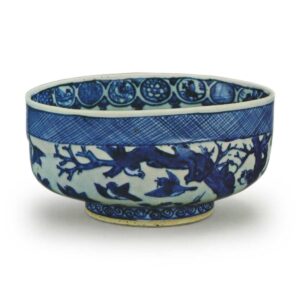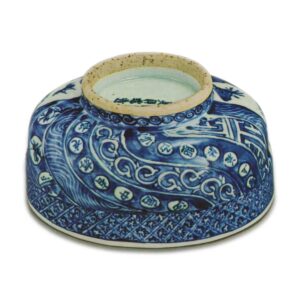

Fujita Art Museum
Height: 5.9 – 6.2 cm
Diameter: 10.0 – 12.9 cm
Outer diameter of foot: 6.5 cm
Height of foot: 1.1 cm
This is one of the most famous of the Hontei Shōzu tea bowls, and it has long been known as the Shōzu of the Fujita family. The promise is well-arranged, the finish is excellent, and it is a work of art that is hard to fault.
As usual, the foot of the foot ring is slightly yellowed with a faint trace of the color of the fire, and it is made of white clay with fine sesame sprinkled on it. After the glaze was applied, this part was lightly scraped and smoothed, so the boundary between the glazed and unglazed parts is clear, and there is no rough feeling characteristic of unglazed parts. This is extremely careful work.
The bowl shape looks like a round washbasin, but it is a very complex piece. The side walls do not rise straight up, but instead cut in halfway and then rise again. So when you look at the inside, it feels like the inside is deep and wide, and it is a very good shape for a tea bowl. And when you hold it in your hand, your fingers rest on this step, and it is very stable to hold. It is a well-made piece.
The outside of this teacup has a different pattern on each side, but the shape of the bowl is based on the way the two sides are pressed together when you hold it in your hand. In other words, it is made in the shape of a shoe. The gentle curve of this shoe-shaped teacup makes it even more comfortable to hold. It is truly a teacup that was born to be a teacup.
The pure white surface is decorated with a stylish pattern in the beautiful indigo unique to Shōzu. The indigo color is a violet blue that was popular during the Shōtoku and Kajō periods of the Ming Dynasty, and it is difficult to achieve this color unless the quality of the gosu is very good. As this was a specially selected order, they must have used the best ingredients. As mentioned earlier, the exterior consists of two different patterns. One side depicts a flock of birds flying around a dead tree, and on the other side, a twisted candy-like auspicious pattern is painted in white on a lapis-dyed background. The upper edge of the sparrow design is decorated with a fine reticulated pattern, and the cobblestone pattern is arranged above the auspicious pattern.
The foot of the foot ring is decorated with a stylized arabesque pattern.
On the inside, the same Shoun-ryu round-patterned interlacing is also drawn around the rim, and short pendants hang down from between the round patterns. The round patterns are decorated with birds and flowers, as well as rather elaborate patterns such as a lone fisherman and a geisha on a horse, which are fun to look at.
Inner box: paulownia wood, plain finish, with the inscription “Shourui, with the name of the tea pit” on the lid, by Toda Rogen
Outer box: Shunkei lacquerware
(by Masahiko Sato)



